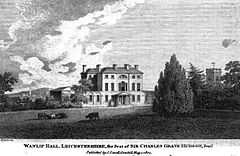Palmer baronets
There have been seven baronetcies created for persons with the surname Palmer, two in the Baronetage of England, one in the Baronetage of Ireland, one in the Baronetage of Great Britain and three in the Baronetage of the United Kingdom. Four of the creations are extant as of 2008.
The Palmer Baronetcy, of Wingham in the County of Kent, was created in the Baronetage of England on 29 June 1621 for Thomas Palmer. The third Baronet was High Sheriff of Kent in 1691. The fourth Baronet sat as Member of Parliament for Kent and Rochester. The title became extinct on the death of the sixth Baronet in 1838.[1]
The Palmer Baronetcy, of Carlton in the County of Northampton,[2] was created in the Baronetage of England on 7 June 1660 for the lawyer and politician Geoffrey Palmer. The second Baronet was Member of Parliament for Higham Ferrers. The third, fourth and fifth Baronets all represented Leicestershire in the House of Commons. The fifth Baronet served as High Sheriff of Leicestershire in 1782 and the eighth Baronet as High Sheriff of Northamptonshire in 1871. The family seat for some 500 years was East Carlton Hall, Northamptonshire until 1933 since when it has been Carlton Curlieu Hall, Leicestershire.[3]
The Palmer Baronetcy, of Castle Lackin in the County of Mayo, was created in the Baronetage of Ireland on 29 May 1777 for Roger Palmer. The fifth Baronet sat as Member of Parliament for County Mayo. The title became extinct on his death in 1910.
The Hudson, later Palmer Baronetcy, of Wanlip Hall in the County of Leicester, was created in the Baronetage of Great Britain on 28 July 1791 for Charles Grave Hudson, a Director of the South Sea Company and High Sheriff of Leicestershire in 1784. In 1813 the second Baronet assumed by Royal sign-manual the surname of Palmer in lieu of his patronymic on succeeding to the estates of his maternal grandfather, Henry Palmer, of Wanlip.
The Palmer Baronetcy, of Grinkle Park in the County of York and of Newcastle upon Tyne, was created in the Baronetage of the United Kingdom on 31 July 1886 for Charles Palmer, a coal and shipping magnate and Liberal politician. The third Baronet, residing at Walworth Castle was High Sheriff of Durham in 1915.
The Palmer Baronetcy, of Reading in the County of Berkshire, was created in the Baronetage of the United Kingdom on 25 August 1904 for Walter Palmer, Member of Parliament for Salisbury and the son of George Palmer, the founder of Huntley & Palmers, biscuit manufacturers. The title became extinct on his death in 1910.
The Palmer Baronetcy, of Grosvenor Crescent in the City of Westminster, was created in the Baronetage of the United Kingdom on 26 January 1916. For more information on this creation, see Baron Palmer.
Palmer baronets, of Wingham (1621)
- Sir Thomas Palmer, 1st Baronet (1540–1625)
- Sir Thomas Palmer, 2nd Baronet (died 1656)
- Sir Henry Palmer, 3rd Baronet (died 1706)
- Sir Thomas Palmer, 4th Baronet (1682–1723)
- Sir Charles Palmer, 5th Baronet (died 1773)
- Sir Chales Harcourt Palmer, 6th Baronet (1760–1838)
Palmer baronets, of Carlton (1660)
- Sir Geoffrey Palmer, 1st Baronet (1598–1670)
- Sir Lewis Palmer, 2nd Baronet (c. 1630–1713)
- Sir Geoffrey Palmer, 3rd Baronet (1655–1732)
- Sir Thomas Palmer, 4th Baronet (died 1765)
- Sir John Palmer, 5th Baronet (c. 1735–1817)
- Sir Thomas Palmer, 6th Baronet (c. 1795–1817)
- Sir John Henry Palmer, 7th Baronet (1775–1865)
- Sir Geoffrey Palmer, 8th Baronet (1809–1892)
- Sir Lewis Henry Palmer, 9th Baronet (1818–1909)
- Sir Edward Geoffrey Broadley Palmer, 10th Baronet (1864–1925)
- Sir Geoffrey Frederick Neill Palmer, 11th Baronet (1893–1951)
- Sir Geoffrey Christopher John Palmer, 12th Baronet (born 1936)
The heir apparent to the baronetcy is the 12th Baronet's eldest son, Geoffrey Palmer (born 1966).
Palmer baronets of Castle Lackin (1777)
- Sir Roger Palmer, 1st Baronet (died c. 1790)
- Sir John Roger Palmer, 2nd Baronet (died 1819)
- Sir William Henry Palmer, 3rd Baronet (died 1840)
- Sir William Henry Roger Palmer, 4th Baronet (1802–1869)
- Sir Roger William Henry Palmer, 5th Baronet (1832–1910)
Hudson, later Palmer baronets, of Wanlip Hall (1791)

- Sir Charles Grave Hudson, 1st Baronet (1730–1813)[4]
- Sir Charles Thomas Hudson Palmer, 2nd Baronet (1771–1827)[5]
- Sir George Joseph Palmer, 3rd Baronet (1811–1866)
- Sir Archdale Robert Palmer, 4th Baronet (1838–1905)
- Sir George Hudson Palmer, 5th Baronet (1841–1919)
- Sir Frederick Archdale Palmer, 6th Baronet (1857–1933)
- Sir John Archdale Palmer, 7th Baronet (1894–1963)
- Sir John Edward Somerset Palmer, 8th Baronet (born 1926)
The heir apparent to the baronetcy is Robert John Hudson Palmer (born 1960), eldest son of the 8th Baronet.
Palmer baronets, of Grinkle Park and of Newcastle-upon-Tyne (1886)
- Sir Charles Mark Palmer, 1st Baronet (1822–1907)
- Sir George Robson Palmer, 2nd Baronet (1849–1910)
- Sir Alfred Molyneux Palmer, 3rd Baronet (1853–1935)
- Sir Anthony Frederick Mark Palmer, 4th Baronet (1914–1941)
- Sir (Charles) Mark Palmer, 5th Baronet (born 1941)
The heir apparent is Arthur Morris Palmer (born 1981), only son of the 5th Baronet.
Palmer baronets, of Reading (1904)
- Sir Walter Palmer, 1st Baronet (1858–1910)
Palmer baronets, of Grosvenor Crescent (1916)
- see Baron Palmer
Notes
- ↑ George Edward Cokayne Complete Baronetage Volume 1 1900
- ↑ A Genealogical and Heraldic Dictionary of the Peerage and Baronetage of the British Empire Vol. I. 4th Edition . John Burke (1832) p278. Google Books
- ↑ Palmer Manuscripts National Archives:Leicestershire, Leicester and Rutland Record Office Ref No. DE1110
- ↑ The Gentleman's Magazine (London, England), Volume 114. 1813. p. 406. Retrieved 28 June 2014.
- ↑ Obituary, The Gentleman's Magazine, and Historical Chronicle, Volume 97, Part 1
References
- Kidd, Charles, Williamson, David (editors). Debrett's Peerage and Baronetage (1990 edition). New York: St Martin's Press, 1990,
- Leigh Rayment's list of baronets